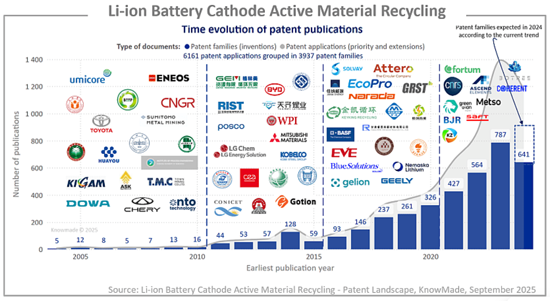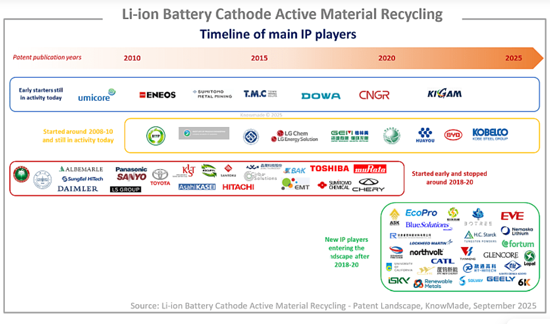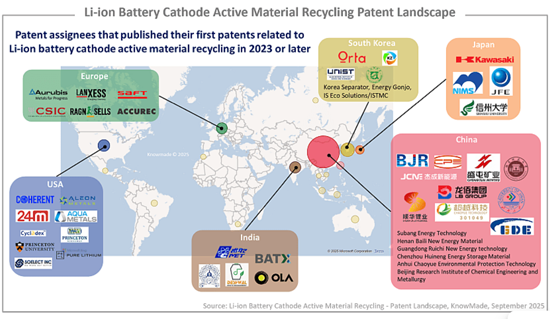|
市場調查報告書
商品編碼
1828243
鋰離子電池正極活性材料回收的專利趨勢分析(2025年)Li-ion Battery Cathode Active Material Recycling Patent Landscape Analysis 2025 |
|||||||
全球鋰離子電池正極活性材料回收專利競爭中的主要和新進入者有哪些?
主要特點
- PDF 120 張投影片
- Excel 資料庫包含本報告分析的所有專利(超過 3,900 個同族專利)
- 全球專利趨勢,包括專利公佈時間表和專利申請國家/地區
- 按地區分類的主要專利申請人和新進入者
- 專注於主要公司專利組合
- 以正極活性材料類型分類的專利(鋰三元氧化物、鋰磷酸鹽、其他正極活性材料 (CAM)、鋰和鋰前驅體)
對永續供應鏈日益增長的興趣和需求,正在推動創新者加入鋰離子電池正極活性材料回收的專利競爭電池。
隨著電動車 (EV)、再生能源儲存系統和便攜式電子產品的迅速普及,鋰離子電池的需求呈指數級增長。為了建立更永續的供應鏈,並增強對材料匱乏國家關鍵礦產供應商的獨立性,人們對鋰、鈷、鎳和錳等關鍵原料的興趣日益濃厚。這種供應集中,加上環境問題和不斷變化的監管框架,正在推動對永續報廢管理策略的需求,特別是報廢鋰離子電池及其正極材料的回收利用。
正極材料是鋰離子電池中最有價值且資源密集的組成部分。這些材料包括層狀氧化物,如 NMC(LiNiMnCoO2)、NCA(LiNiCoAlO2)和 LCO(LiCoO2),多陰離子材料,如 LFP(LiFePO4)和 LMFP(LiMnFePO4),以及尖晶石,如 LMO(LiMn2O4)。每種化學品的回收和再利用都面臨獨特的課題和機會。高效率的回收不僅可以減少對原始採礦的依賴,還可以降低電池製造的環境足跡,並有助於實現政府和產業設定的循環經濟目標。
為此,本報告旨在全面分析與鋰離子電池正極活性材料 (CAM) 回收相關的專利模式。
本報告的總體目標如下:
- 識別並繪製每個技術領域(鋰和鋰前驅體、鋰三元氧化物、鋰磷酸鹽和其他正極材料)的關鍵智慧財產權參與者。 評估同族專利的地理分佈和專利申請的法律狀態,使利害關係人能夠了解其策略定位並應對競爭格局。
這些洞察將支持不斷發展的鋰離子電池回收領域的研發、投資和政策決策。

動態智慧財產權格局
在本報告中,Knowmade分析師從3,900多個專利族(發明)中篩選並分析了6,100多項與鋰離子電池正極活性材料回收相關的專利和專利申請。這一顯著增長清楚地表明,包括大型企業、新創公司和研發實驗室在內的眾多實體對該技術表現出濃厚的興趣。繼Umicore、Eneos和住友金屬礦業(例如LG化學/LGES、GEM和Brunp Recycling Technology)等早期進入該領域的企業之後,他們現在正與Asaka Riken、EcoPro和Blue Solutions等新進入者競爭。
辨識關鍵趨勢與關鍵參與者的智慧財產權地位
智慧財產權競爭分析必須反映參與者的願景,並制定進入鋰離子電池可視性儲存 (CAM) 回收領域並發展業務的策略。在本報告中,KnowMade 分析師全面概述了競爭格局和關鍵參與者。報告涵蓋了專利申請量、專利申請人、申請國家以及關鍵技術領域(鋰和鋰前驅體、鋰三元氧化物、鋰磷酸鹽等)的智慧財產權動態和關鍵趨勢。報告還識別了知識產權領域的領導者、最活躍的專利申請人以及新進入者。本報告也揭示了該領域中一些不為人知的公司和新進者。

新專利申請人進入
自2023年以來,中國企業已成為鋰離子電池CAM回收專利市場的主要新進者。 BJR、CP Lighting和Chengtun Mining Group處於領先地位,其次是東亞的智慧財產權進入者,例如韓國的Orta Materials和Korea Zinc,以及日本的JFE和川崎重工。本報告重點在於各國主要進入者和新進者的專利組合。

便利的 Excel 專利資料庫
本報告還包含一個全面的 Excel 資料庫,其中包含本研究中分析的所有專利,包括專利資訊(編號、日期、受讓人、標題、摘要等)、指向更新的線上資料庫的超連結(源文本、法律狀態等)以及細分領域(鋰及鋰前驅體、鋰三元氧化物、鋰磷酸鹽、其他正極材料)。
報告中涉及的公司(非詳盡)
- 中國:邦普循環科技、中南大學、中科院製程工程研究所、荊門格林美新材料股份有限公司、南都電源、北京理工大學、天齊鋰業、國軒高科、凱景再生資源、北控科技集團、RSK先進材料、株冶煉集團、億緯鋰能、蘭州理工大學等。
- 歐洲:優美科、巴斯夫、CEA、Blue Solutions、威立雅、Aurubis、富騰、美卓、弗勞恩霍夫應用研究所等。
- 日本:埃內奧斯集團、住友金屬礦、同及控股、TMC(城鎮礦業公司)、朝霞理研、豐田、三菱材料、神戶鋼鐵、三井金屬礦業、住友化學/田中化學、日立等。
- 韓國:SK集團、LG化學/LG能源解決方案、韓國地質礦產資源研究院 (KIGAM)、EcoPro、韓國工業技術研究院 (RIST)、浦項製鐵、Cosmochemical、韓國科學技術研究院 (KIST)、Dongwoo FinceChem 等。
- 美國:Ascend Elements、伍斯特理工學院、OnTo Technology、Albemarle、洛克希德馬丁/UT Battelle、Cirba Solutions、Coherent、加州大學、Libus987、Urban Mining、24M technologies、6K inc. Aleon Metals、Aquacles、Li-Cy Metal 等。
- 其他地區:CSIR(科學與工業研究理事會)、Attero Recycling、Conicet、Gelion Technologies、Green Li-ion、印第安納理工學院、Frontier Lithium、Hydro-Quebec 等。
目錄
簡介
摘要整理
專利形勢概要
- 主要趨勢和IP參與企業
- 專利揭露時間序列
- 主要專利權人
- 知識產權參與者時間軸
- 專利申請主要國家/地區
- 已授權和待批專利的地理覆蓋範圍
- 參與者專利的地理分佈專利組合
- 專利的當前法律狀態(已授權、待審、已過期)
- 主要專利持有者
- 專利申請的主要參與者
- 專利權人的智慧財產權領導力
- 參與者的專利組合強度指數
- 關注回收公司
- 關注2023年及以後的智慧財產權新進者
技術領域
- 依正極活性材料回收細分的技術
- 專利出版品隨時間的變化
- 依正極活性材料回收劃分的主要專利權人
- 以正極活性材料劃分的專利出版趨勢
- 鋰和鋰前驅體回收領域專利權人的智慧財產權領導力
- 鋰三元氧化物領域專利權人的智慧財產權領導力回收利用
- 磷酸鋰回收領域專利權人的智慧財產權領導力
- 其他CAM回收領域專利權人的智慧財產權領導力
關注總部所在國家的智慧財產權進入者
- 針對每個總部所在國家,列出主要專利權人、智慧財產權新進入者、專利組合的地理範圍、專利組合的技術範圍、主要進入者的智慧財產權概況。
- 中國的IP參與企業
- 日本的IP參與企業
- 韓國的IP參與企業
- 美國的IP參與企業
- 歐洲的IP參與企業
- 其他地區
另紙
- 專利搜尋,選擇,分析的調查手法
- 用語
noumeidopurezenteshon
Who are the key players and newcomers in the global IP race for Li-ion batteries cathode active materials recycling?
Key features:
- PDF>120 slides
- Excel database containing all patents analyzed in the report (>3,900 patent families), including patent segmentations and hyperlinks to an updated online database.
- Global patenting trends, including time evolution of patent publications, countries of patent filings, etc.
- Main patent assignees and IP newcomers grouped by geographical area.
- Focus on selected key IP players' portfolios
- Patents categorized by type of cathode active material (Li Ternary Oxides, Li Phosphates, Other CAM, Li & Li Precursors).
The growing interest in, and need for, a sustainable supply chain has driven innovators into an IP race in Li-ion battery CAM recycling
The rapid adoption of electric vehicles (EVs), renewable energy storage systems, and portable electronics has fueled an exponential increase in the demand for Lithium-ion batteries. The interest in critical raw materials such as lithium, cobalt, nickel, and manganese, increased, to instate a more sustainable supply chain and increase the independence of materials-scarce countries from critical minerals suppliers. This concentration of supply, coupled with environmental concerns and evolving regulatory frameworks, has intensified the need for sustainable end-of-life management strategies, particularly the recycling of spent Li-ion batteries and their cathode materials.
Cathode materials represent the most valuable and resource-intensive components of Li-ion batteries. These include layered oxides like NMC (LiNiMnCoO2), NCA (LiNiCoAlO2), and LCO (LiCoO2); polyanion materials such as LFP (LiFePO4) and LMFP (LiMnFePO4); and spinels like LMO (LiMn2O4). Each chemistry presents unique challenges and opportunities for recovery and reuse. Efficient recycling not only reduces reliance on virgin mining but also lowers the environmental footprint of battery production, contributing to the circular economy goals set by governments and industries.
In this context, the present report aims to provide a comprehensive analysis of the patent landscape related to the recycling of cathode active materials (CAM) from Li-ion batteries.
The general objectives of the present report are:
- to identify and map the key IP players in each chosen technological segment (Li & Li precursors, Li ternary oxides, Li phosphates, other cathode materials).
- to assess the geographical distribution of patent families, legal status of patent applications, helping stakeholders understand strategic positioning and navigate their competitive environment.
This insight will support R&D, investment, and policy decisions in the evolving field of Li-ion battery recycling.

A dynamic IP landscape
In this report, Knowmade's analysts have selected and analyzed over 6,100 patents and patent applications from more than 3,900 patent families (inventions) related to Li-ion battery cathode active materials recycling. This significant rise clearly demonstrates a strong interest in the technology from various entities, including large companies, start-ups, and R&D labs. Early entrants in this space such as Umicore, Eneos, and Sumitomo Metal Mining were followed over the years by other patent applicants (e.g., LG Chem/LGES, GEM, Brunp Recycling Technology), and they are now competing with more recent new entrants in the patent landscape such as Asaka Riken, EcoPro, and Blue Solutions.
Revealing main trends and key players' IP position
IP competition analysis should reflect the vision of players with a strategy to enter and develop their business in the Li-ion battery CAM recycling field. In this report, KnowMade's analysts provide a comprehensive overview of the competitive IP landscape and the main players involved. The report covers IP dynamics and key trends in terms of patents applications, patent assignees, filing countries, and technological segment of interest (Li & Li precursors, Li ternary oxides, Li phosphates, etc.). It also identifies the IP leaders, most active patent applicants, and new entrants in the IP landscape. The report also sheds light on under-the-radar companies and new players in this field.

Entry of new patent applicants
Since 2023, Chinese entities have established themselves as dominant newcomers in the Li-ion battery CAM recycling patent landscape. BJR, CP Lighting, and Chengtun Mining Group are leading the field, while other East Asian IP players such as Orta Materials and Korea Zinc from South Korea, and JFE and Kawasaki Heavy Industries from Japan are following closely behind. Dedicated sections of the report focus on the patent portfolios of key players and IP new entrants from various countries.

Useful Excel patent database
This report also includes an extensive Excel database with all patents analyzed in this study, including patent information (numbers, dates, assignees, title, abstract, etc.) and hyperlinks to an updated online database (original documents, legal status, etc.), and affiliation segments (Li & Li precursors, Li ternary oxides, Li phosphates, other cathode materials).
Companies mentioned in the report (non-exhaustive)
- From China: Brunp Recycling technology, Central South University, Institute of Process Engineering-CAS, GEM (Jingmen Gelinmei New Materials), Narada Power Source, Beijing Institute of Technology, Tianqi Lithium, Guoxuan High Tech Power Energy / Gotion, Keyking Recycling, BGRIMM Technology Group, RSK Advanced materials, Zhuzhou Smelter Group, EVE Energy, Lanzhou University of Technology, and more
- From Europe: Umicore, BASF, CEA, Blue Solutions, Veolia, Aurubis, Fortum, Metso, Fraunhofer, and more
- From Japan: Eneos Group, Sumitomo Metal Mining, Dowa Holdings, TMC (Town Mining Corporation), Asaka Riken, Toyota, Mitsubishi materials, Kobe Steel, Mitsui Mining and Smelting, Sumitomo Chemical/Tanaka Chemical, Hitachi, and more
- From South Korea: SK Group, LG Chem/LG Energy Solution, KIGAM (Korea Insttitue of Geoscience and Mineral Resources), EcoPro, RIST (Research Institute of Industrial Science and Technology), Posco, Cosmochemical, KIST (Korea Institute of Science & Technology), Dongwoo Fince Chem, and more
- From USA: Ascend Elements, Worcester Polytechnic Institute, OnTo Technology, Albemarle, Lockheed Martin/UT Battelle, Cirba Solutions, Coherent, University of California, Libus987, Urban Mining, 24M technologies, 6K inc. Aleon Metals, Aqua Metals, Li-Cycle, and more
- From the rest of the World: CSIR (Council of Scientific and Industrial Research), Attero Recycling, Conicet, Gelion Technologies, Green Li-ion, Indiana Institute of Technology, Frontier Lithium, Hydro-Quebec, and more
TABLE OF CONTENTS
INTRODUCTION
- Context & objectives of the report
- Scope of the report
- Excel database
- Basic knowledge of IP to better understand this report
EXECUTIVE SUMMARY
PATENT LANDSCAPE OVERVIEW
- Main Trends and IP Players
- Time evolution of patent publications
- Main patent assignees
- Timeline of IP players
- Main countries of patent filings
- Geographic coverage of granted patents and pending applications
- Geographical distribution of players' patent portfolios
- Current legal status of patents (granted, pending, dead)
- Main players owning granted patents
- Main players that hold pending patent applications
- IP leadership of patent assignees
- Strength index of players' patent portfolios
- Focus on Recycling Companies
- Focus on IP Newcomers Since 2023
TECHNOLOGICAL SEGMENTS
- Technology breakdown by cathode active materials recycling
- Time evolution of patent publications
- Main patent assignees by cathode active materials recycling
- Time evolution of patent publications by cathode active materials
- IP leadership of patent assignees for Li & Li Precursors recycling
- IP leadership of patent assignees for Li Ternary Oxides recycling
- IP leadership of patent assignees for Li Phosphates recycling
- IP leadership of patent assignees for other CAM recycling
FOCUS ON IP PLAYERS BY HEADQUARTERS COUNTRY
- For each headquarters country: main patent assignees, IP newcomers, geographical coverage of patent portfolios, technical coverage of patent portfolios, and IP profile of key players.
- Chinese IP players
- Japanese IP players
- South Korean IP players
- American IP players
- European IP players
- Rest of the World
ANNEX
- Methodology for patent search, selection and analysis
- Terminology












